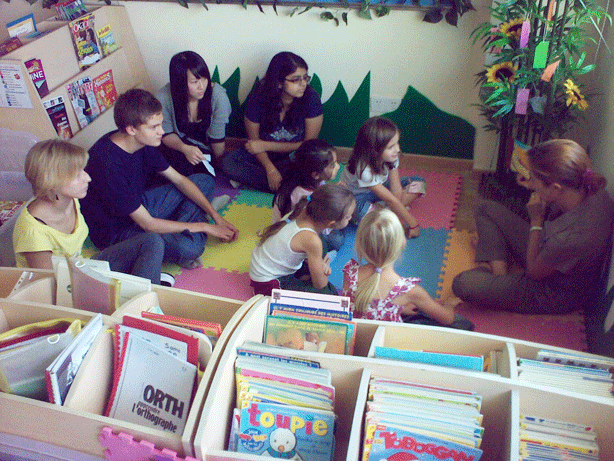 Since China’s second stage of opening-up took effect in the 1990s, the number of international schools for foreign students in China’s first- and second-tier cities has grown rapidly. At present there are 654 international schools in China, with almost one third of that number in Hong Kong. The European Chamber’s Position Paper 2014/2015 recommends further improving access to schools by “the development of more foreign schools to offer consumers a wider choice”.[1] Elaine Whelen, founding head of ISA International School Guangzhou, says that today’s China doesn’t just need more foreign schools, it needs more schools that offer multilingual curricula, to develop truly international talent.
Since China’s second stage of opening-up took effect in the 1990s, the number of international schools for foreign students in China’s first- and second-tier cities has grown rapidly. At present there are 654 international schools in China, with almost one third of that number in Hong Kong. The European Chamber’s Position Paper 2014/2015 recommends further improving access to schools by “the development of more foreign schools to offer consumers a wider choice”.[1] Elaine Whelen, founding head of ISA International School Guangzhou, says that today’s China doesn’t just need more foreign schools, it needs more schools that offer multilingual curricula, to develop truly international talent.
English has historically been the most desirable first language in international schools in China. Parents and students understood that it is the gateway language to gain access to schools and universities in the three most desirable study destinations – the United States (US), the United Kingdom (UK) and Australia. China’s economic success story has seen the pendulum swing, though, with Chinese emerging as an equally powerful gateway language. People now want to learn Chinese, study in China and do business with China.
Student migration trends are also changing. Overseas schools are sending students to China to learn Chinese and China is starting to rival the UK and the US as an overseas study destination. According to a 2011 projection by the Organisation for Economic Cooperation and Development (OECD), the number of students studying outside their home country in 2020 will be seven million, compared with 3.67 million in 2009 and 2.07 million in 2000. [2]
Three distinct groups are in need of a new type of international education in China:
- Returning Chinese passport holders: This group have no choice but to enter the local school system, but often lack reading and writing skills in Chinese. The Human Resources Working Group/Forum rightly recommends that these children be allowed to enter international schools. However, they need quality Chinese language programmes to catch up, not merely three hours or less per week.
- Returning Chinese with foreign residency or passports: This group emerged in large numbers over the past 10 years, and are now able to enrol in international schools.
- Students attending local schools with an integrated curriculum where up to one third of the curriculum is delivered in a Western style: The ‘untouchable’ subjects are Chinese, Mathematics and English. These must be taught according to national, provincial or municipal requirements.
 International schools in China must respond to this dramatic demographic change in student population to provide access and opportunities for all students, Chinese and foreign, with more substantial Chinese language instruction. It is time for a new model of international schools to emerge, embracing the best of Eastern and Western curricula, philosophies, and educational practices with a more diverse teaching staff. A blend of English and Chinese language is required to prepare students for the future. ‘International’ does not mean ‘being Western’ – a truly international education should equip students with the skills to become part of a global workforce, providing them with the linguistic and other skill sets they require to become the innovators, problem-solvers and team players needed in the 21st century workplace.
International schools in China must respond to this dramatic demographic change in student population to provide access and opportunities for all students, Chinese and foreign, with more substantial Chinese language instruction. It is time for a new model of international schools to emerge, embracing the best of Eastern and Western curricula, philosophies, and educational practices with a more diverse teaching staff. A blend of English and Chinese language is required to prepare students for the future. ‘International’ does not mean ‘being Western’ – a truly international education should equip students with the skills to become part of a global workforce, providing them with the linguistic and other skill sets they require to become the innovators, problem-solvers and team players needed in the 21st century workplace.
Parents expect to have a choice and a growing number are choosing bilingual and multilingual schools for their children. The choice, or lack, of schools has a direct impact on China’s ability to attract a global workforce: twenty-five percent of European Chamber members ranked schools as one of their top three challenges when trying to attract and retain expat talent.[3]
Recent research in the US has shown that students who learn bilingually have higher cognitive and executive function and outperform their monolingual peers in all subject areas, including maths and science.[4] Given the importance of the Chinese and English languages and this added benefit of producing higher-performing students, international schools need to adapt or become fossilised.
Wherever a person is from, they need to navigate a globalised world. Too often, students enter a foreign country or an international school and think that they need to assimilate by rejecting their mother tongue or adopting accents and mannerisms of their new environment to ‘blend in’ with their peer group as quickly as possible. Through this process they lose more than their native language skills, they sacrifice their cultural identity too. That is not ‘international’. We need an additive, not a subtractive, approach to language acquisition.
Chinese students locked into preparation for the zhongkao and gaokao are denied a broad and balanced curriculum. Many of them can access international schools as an alternative, but they must sacrifice their literacy and fluency in their mother tongue, which is a high price to pay. A recent article in EURObiz makes a link between the needs of the 21st century workplace and the dearth of useful skill sets due to the narrow focus on examination preparation in local schools.[5]
Chinese and foreign families require quality bilingual and trilingual programmes. English should no longer be seen as the only gateway language and schools should not allow students to sacrifice literacy in their mother tongue in order to learn English. It is time to review what it means to be an international school, to understand the changing demographics and to build on student’s cultural and linguistic capital to help develop the next generation of international talent.
Elaine Whelen’s experience in education spans three decades, with 15 years as the leader of four international schools around the world, including schools in Europe, Asia and Africa. Her experience and expertise in the fields of mother tongue and multilingual programmes is significant.
[1] Human Resources Position Paper 2014/2015, European Union Chamber of Commerce in China, 2014, p. 71, <http://www.europeanchamber.com.cn/en/publications-position-paper>
[2] Education at a Glance 2011: OECD Indicators, Organisation for Economic Cooperation and Development, OECD Publishing, 2011, <http://dx.doi.org/10.1787/eag-2011-en>
[3] Business Confidence Survey 2014, European Union Chamber of Commerce in China, June 2014, page 17, <http://www.europeanchamber.com.cn/en/publications-business-confidence-survey>
[4] Bialystok, Ellen (2011); Cummins, Jim et al (2008); Collier, Wayne & Thomas, Virginia (1997)
[5] Hoey, Patrick, Going Global with Education, EURObiz, July/August 2014, <http://www.eurobiz.com.cn/going-global-education-internationalising-chinese-curriculum-means-european-businesses/>


Recent Comments